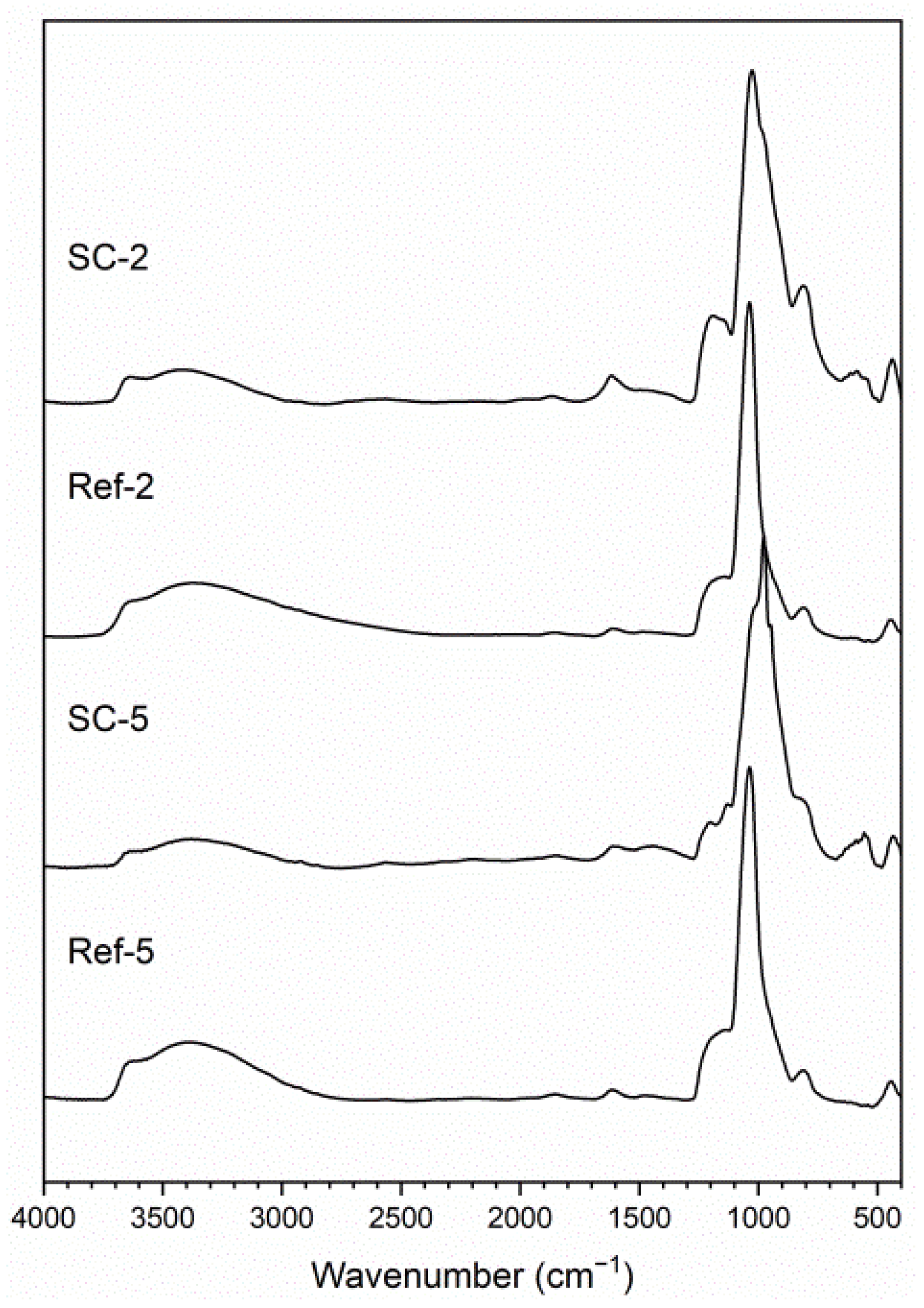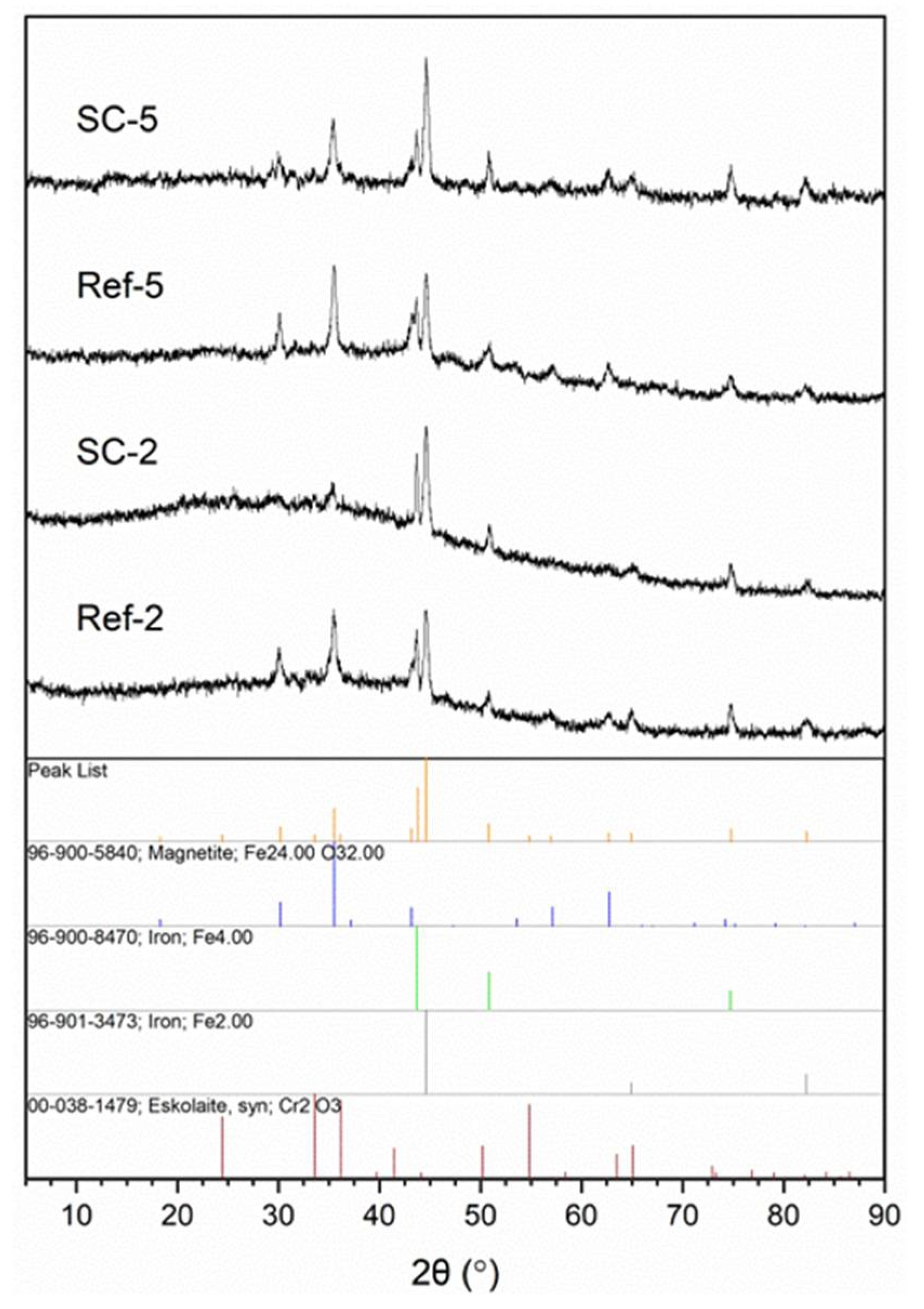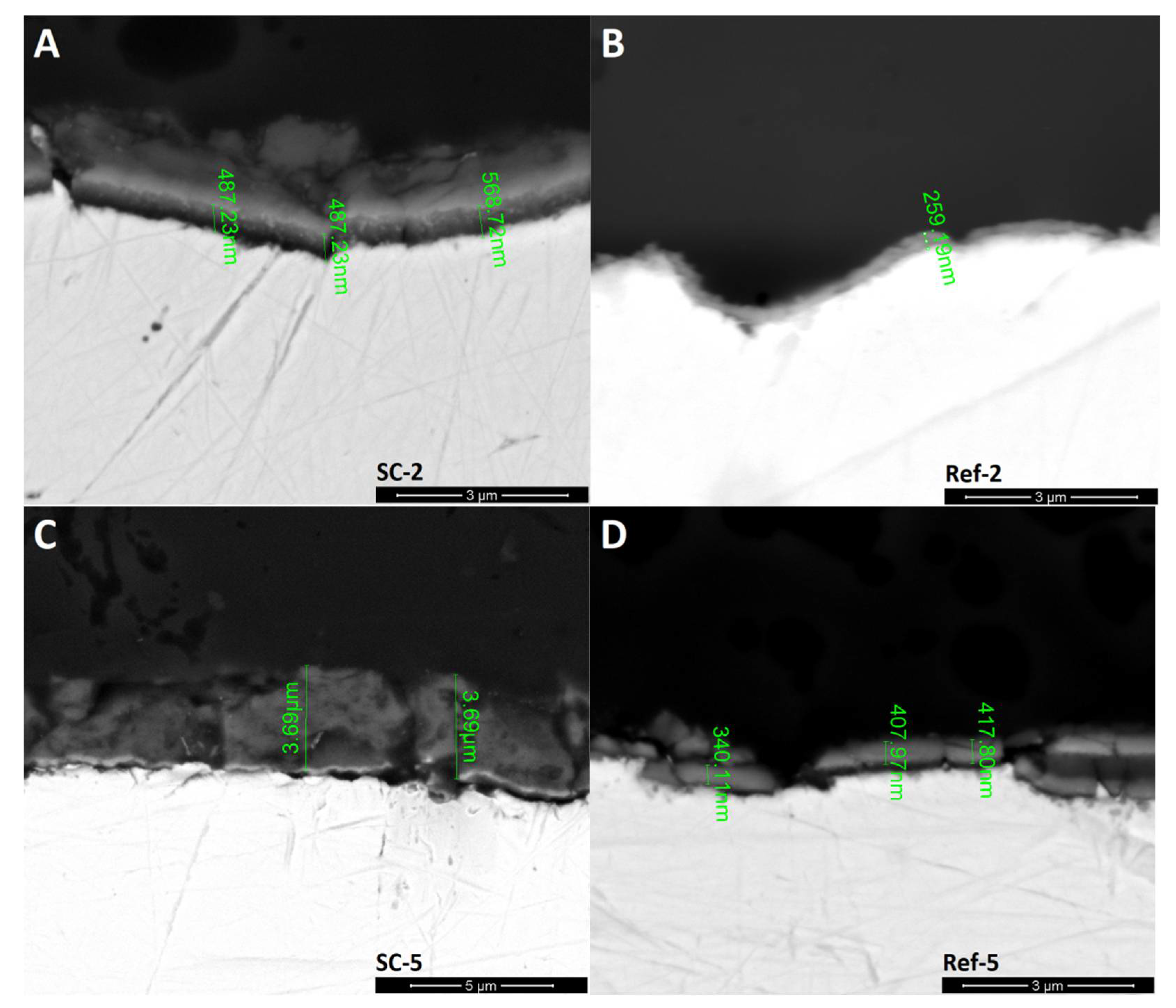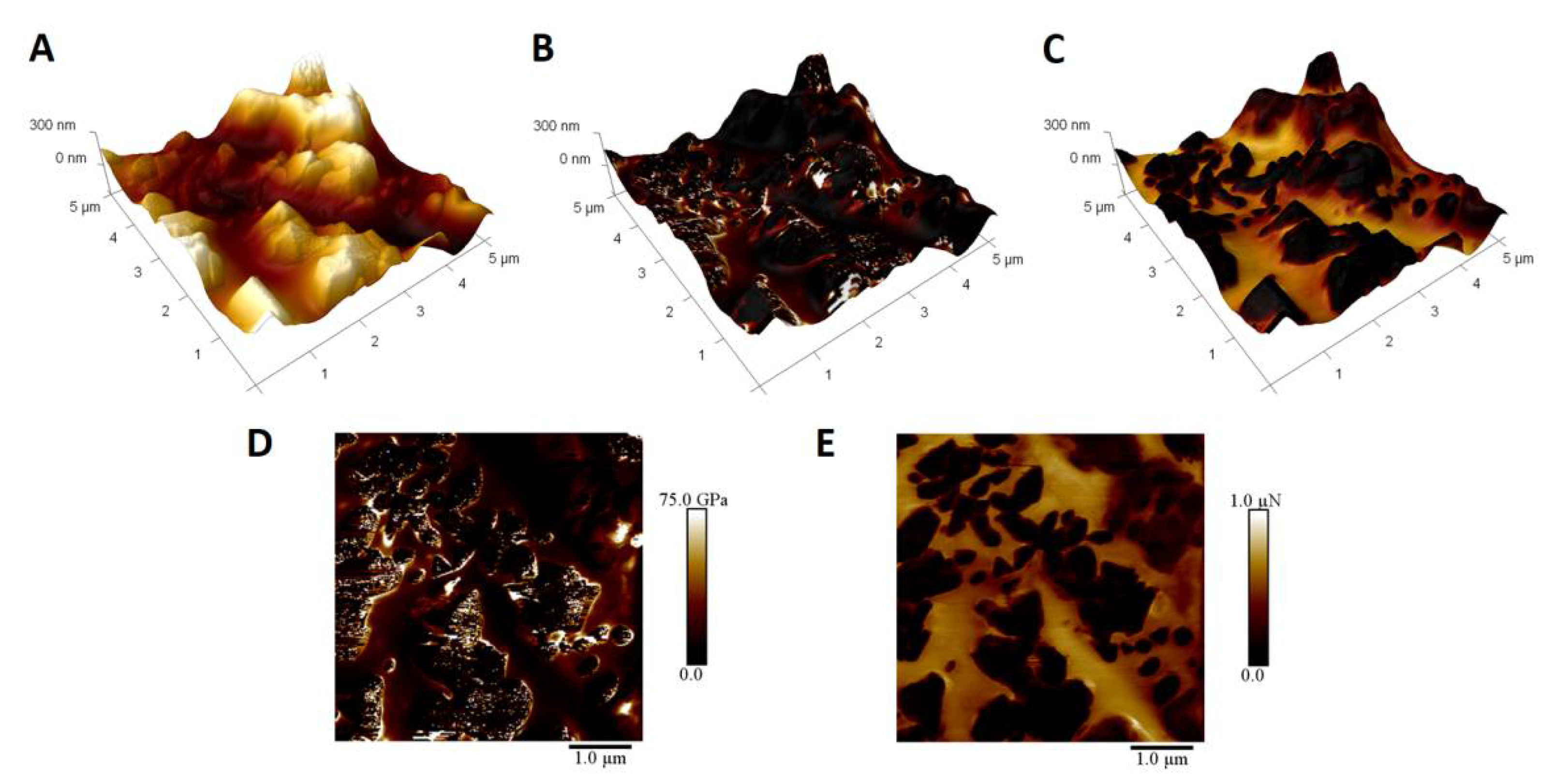Novel Solid Silicon Oxycarbide Unmodified Carbon Nanotube Composite Coating: Structure, Topography and Mechanical Properties
Abstract
:1. Introduction
2. Materials and Methods
3. Results and Discussion
3.1. Structure Characterization
3.2. Coating Morphology and Thickness
3.3. Mechanical Properties
3.4. Coating Conductivity
4. Conclusions
Author Contributions
Funding
Institutional Review Board Statement
Informed Consent Statement
Data Availability Statement
Acknowledgments
Conflicts of Interest
References
- Ming, K.; Gu, C.; Su, Q.; Wang, Y.; Zare, A.; Lucca, D.A.; Nastasi, M.; Wang, J. Strength and plasticity of amorphous silicon oxycarbide. J. Nucl. Mater. 2019, 516, 289–296. [Google Scholar] [CrossRef] [Green Version]
- Szymanski, W.; Lipa, S.; Fortuniak, W.; Chojnowski, J.; Pospiech, P.; Mizerska, U.; Slomkowski, S.; Nyczyk-Malinowska, A.; Hasik, M. Silicon oxycarbide (SiOC) ceramic microspheres-Structure and mechanical properties by nanoindentation studies. Ceram. Int. 2019, 45, 11946–11954. [Google Scholar] [CrossRef]
- Nyczyk-Malinowska, A.; Niemiec, W.; Smoła, G.; Gaweł, R.; Szuwarzyński, M.; Grzesik, Z. Preparation and characterization of oxidation-resistant black glass (SiCO) coatings obtained by hydrosilylation of polysiloxanes. Surf. Coat. Technol. 2021, 407, 126760. [Google Scholar] [CrossRef]
- Guo, F.; Su, D.; Liu, Y.; Wang, J.; Yan, X.; Chen, J.; Chen, S. High acid resistant SiOC ceramic membranes for wastewater treatment. Ceram. Int. 2018, 44, 13444–13448. [Google Scholar] [CrossRef]
- Saha, A.; Raj, R.; Williamson, D.L. A model for the nanodomains in polymer-derived SiCO. J. Am. Ceram. Soc. 2006, 89, 2188–2195. [Google Scholar] [CrossRef]
- Song, J.; Huang, R.; Zhang, Y.; Lin, Z.; Zhang, W.; Li, H.; Song, C.; Guo, Y.; Lin, Z. Effect of nitrogen doping on the photoluminescence of amorphous silicon oxycarbide films. Micromachines 2019, 10, 649. [Google Scholar] [CrossRef] [PubMed] [Green Version]
- Uznanski, P.; Walkiewicz-Pietrzykowska, A.; Jankowski, K.; Zakrzewska, J.; Wrobel, A.M.; Balcerzak, J.; Tyczkowski, J. Atomic hydrogen induced chemical vapor deposition of silicon oxycarbide thin films derived from diethoxymethylsilane precursor. Appl. Organomet. Chem. 2020, 34, e5674. [Google Scholar] [CrossRef]
- Pantano, C.G.; Singh, A.K.; Zhang, H. Silicon oxycarbide glasses. J. Sol Gel Sci. Technol. 1999, 14, 7–25. [Google Scholar] [CrossRef]
- Zhang, H.; D’Angelo Nunes, P.; Wilhelm, M.; Rezwan, K. Hierarchically ordered micro/meso/macroporous polymer-derived ceramic monoliths fabricated by freeze-casting. J. Eur. Ceram. Soc. 2016, 36, 51–58. [Google Scholar] [CrossRef]
- Huang, K.; Elsayed, H.; Franchin, G.; Colombo, P. Complex SiOC ceramics from 2D structures by 3D printing and origami. Addit. Manuf. 2020, 33, 101144. [Google Scholar] [CrossRef]
- Chauhan, P.K.; Sujith, R.; Parameshwaran, R.; Prasad, A.V.S.S. Role of polysiloxanes in the synthesis of aligned porous silicon oxycarbide ceramics. Ceram. Int. 2019, 45, 8150–8156. [Google Scholar] [CrossRef]
- Nyczyk-Malinowska, A.; Wójcik-Bania, M.; Gumuła, T.; Hasik, M.; Cypryk, M.; Olejniczak, Z. New precursors to SiCO ceramics derived from linear poly(vinylsiloxanes) of regular chain composition. J. Eur. Ceram. Soc. 2014, 34, 889–902. [Google Scholar] [CrossRef]
- Iwase, Y.; Fuchigami, T.; Horie, Y.; Daiko, Y.; Honda, S.; Iwamoto, Y. Formation and thermal behaviors of ternary silicon oxycarbides derived from silsesquioxane derivatives. Materials 2019, 12, 1721. [Google Scholar] [CrossRef] [PubMed] [Green Version]
- Xie, F.; Ionescu, E.; Arango-Ospina, M.; Riedel, R.; Boccaccini, A.R.; Gonzalo-Juan, I. Facile preparative access to bioactive silicon oxycarbides with tunable porosity. Materials 2019, 12, 3862. [Google Scholar] [CrossRef] [Green Version]
- Mazo, M.A.; Colomer, M.T.; Tamayo, A.; Rubio, J. Microstructure-electrochemical behavior relationships of hierarchically micro-mesoporous silicon oxycarbide derived materials obtained by the pyrolysis of trietoxysilane/dimethyldiphenylsiloxane hybrids. J. Alloys Compd. 2021, 870, 159427. [Google Scholar] [CrossRef]
- Wang, L.; Lu, K.; Ma, R. Effects of different polymer precursors on the characteristics of SiOC bulk ceramics. Appl. Phys. A: Mater. 2019, 125, 395. [Google Scholar] [CrossRef]
- Jeleń, P.; Szumera, M.; Gawęda, M.; Długoń, E.; Sitarz, M. Thermal evolution of ladder-like silsesquioxanes during formation of black glasses. J. Therm. Anal. Calorim. 2017, 130, 103–111. [Google Scholar] [CrossRef] [Green Version]
- Marchewka, J.; Jeleń, P.; Długoń, E.; Sitarz, M.; Błażewicz, M. Spectroscopic investigation of the carbon nanotubes and polysiloxane coatings on titanium surface. J. Mol. Struct. 2020, 1212, 128176. [Google Scholar] [CrossRef]
- Kuo, C.T.; Faber, K.T. Permeable carbon nanotube-reinforced silicon oxycarbide via freeze casting with enhanced mechanical stability. J. Eur. Ceram. Soc. 2020, 40, 2470–2479. [Google Scholar] [CrossRef]
- Jose, M.V.; Dean, D.; Tyner, J.; Price, G.; Nyairo, E. Polypropylene/carbon nanotube nanocomposite fibers: Process-morphology- property relationships. J. Appl. Polym. Sci. 2007, 103, 3844–3850. [Google Scholar] [CrossRef]
- Knozowski, D.; Graczyk-Zajac, M.; Trykowski, G.; Wilamowska-Zawłocka, M. Silicon oxycarbide-graphite electrodes for high-power energy storage devices. Materials 2020, 13, 4302. [Google Scholar] [CrossRef] [PubMed]
- Li, H.; Yan, X.; Ma, Z.; Zhang, Y.; Li, C.; Xiao, W.; Jiang, Y. Silicon oxycarbide-carbon hybrid nanofibers: A promising anode for ultralong-cycle lithium ion batteries with high rate capability. Ceram. Int. 2021, 47, 6867–6874. [Google Scholar] [CrossRef]
- Canuto de Almeida e Silva, T.; Bhowmick, G.D.; Ghangrekar, M.M.; Wilhelm, M.; Rezwan, K. SiOC-based polymer derived-ceramic porous anodes for microbial fuel cells. Biochem. Eng. J. 2019, 148, 29–36. [Google Scholar] [CrossRef]
- Bai, J.; Allaoui, A. Effect of the length and the aggregate size of MWNTs on the improvement efficiency of the mechanical and electrical properties of nanocomposites-experimental investigation. Compos. A Appl. Sci. Manuf. 2003, 34, 689–694. [Google Scholar] [CrossRef]
- Francis, A.P.; Devasena, T. Toxicity of carbon nanotubes: A review. Toxicol. Ind. Health 2018, 34, 200–210. [Google Scholar] [CrossRef] [PubMed]
- Niemiec, W.; Szczygieł, P.; Jeleń, P.; Handke, M. IR investigation on silicon oxycarbide structure obtained from precursors with 1:1 silicon to carbon atoms ratio and various carbon atoms distribution. J. Mol. Struct. 2018, 1164, 217–226. [Google Scholar] [CrossRef]
- Waseda, Y.; Suzuki, S. 4. FT-IR and UV for Iron Hydroxides and Oxides. In Characterization of Corrosion Products on Steel Surfaces; Springer Science & Business Media: Berlin, Germany, 2006. [Google Scholar]
- Sbai, K.; Rahmani, A.; Chadli, H.; Bantignies, J.-L.; Hermet, P.; Sauvajol, J.-L. Infrared spectroscopy of single-walled carbon nanotubes. J. Phys. Chem. B 2006, 110, 12388–12393. [Google Scholar] [CrossRef]







| Atoms | SC-2 | Ref-2 | SC-5 | Ref-5 | Ref-2-Crystallite | SC-2-Above Layer |
|---|---|---|---|---|---|---|
| C | 10.27% | 11.84% | 18.72% | 11.04% | 9.25% | 75.34% |
| O | 27.01% | 25.33% | 35.68% | 24.13% | 37.77% | 17.52% |
| Si | 16.75% | 12.55% | 36.58% | 13.09% | 7.65% | 0% |
| Cr | 11.36% | 12.68% | 2.72% | 12.92% | 14.44% | 0% |
| Mn | 1.37% | 1.08% | 0.74% | 1.62% | 1.11% | 0% |
| Fe | 29.55% | 32.40% | 4.83% | 32.80% | 27.01% | 0% |
| Ni | 3.69% | 4.12% | 0.73% | 4.40% | 2.77% | 0% |
Publisher’s Note: MDPI stays neutral with regard to jurisdictional claims in published maps and institutional affiliations. |
© 2021 by the authors. Licensee MDPI, Basel, Switzerland. This article is an open access article distributed under the terms and conditions of the Creative Commons Attribution (CC BY) license (https://creativecommons.org/licenses/by/4.0/).
Share and Cite
Niemiec, W.; Owińska, M.; Ferenc, A.; Szuwarzyński, M.; Długoń, E. Novel Solid Silicon Oxycarbide Unmodified Carbon Nanotube Composite Coating: Structure, Topography and Mechanical Properties. Coatings 2021, 11, 920. https://doi.org/10.3390/coatings11080920
Niemiec W, Owińska M, Ferenc A, Szuwarzyński M, Długoń E. Novel Solid Silicon Oxycarbide Unmodified Carbon Nanotube Composite Coating: Structure, Topography and Mechanical Properties. Coatings. 2021; 11(8):920. https://doi.org/10.3390/coatings11080920
Chicago/Turabian StyleNiemiec, Wiktor, Maria Owińska, Anna Ferenc, Michał Szuwarzyński, and Elżbieta Długoń. 2021. "Novel Solid Silicon Oxycarbide Unmodified Carbon Nanotube Composite Coating: Structure, Topography and Mechanical Properties" Coatings 11, no. 8: 920. https://doi.org/10.3390/coatings11080920







